“Currently, my goal is to achieve financial freedom by the age of 30. So most of the money I earn, I will reinvest to generate compound interest. I always set a clear financial roadmap for each different age group, because the income level is also different at each age. The more I invest, the more I will earn,”
Thanh Hien (born in 2002, Hanoi) started the conversation with us when talking about her work goals.
Solving the equation for achieving financial freedom has never been easy. There are some people who are 40 or 50 years old and still have this dream, hoping to one day “not go to work but still have something to eat”, but the reality is not so easy. So what has Thanh Hien – a young GenZ – done to prepare for the journey to achieve financial freedom when she is only in her early 20s?

Thanh Hien
No longer FOMO buying iPhone 15, branded bags, or putting a lot of money into clothes
The first step in the journey to achieve financial freedom is that Thanh Hien needs to have savings and a separate fund for investment. So where does this money come from?
Thanh Hien is working as a Marketing staff and after working hours, she teaches English and takes on freelance Marketing jobs. Her total monthly income ranges from 1,3000 USD to 2,000 USD (about 33 – 50 million VND). Since the time her salary was only 10 million VND up to the present total income which is 3-5 times higher, Thanh Hien has always maintained the 40/60 principle, which means spending 40% of the total income on living expenses, and the rest she saves and invests.
To keep living expenses within 40% of her income, Thanh Hien has 2 secrets. Firstly, she keeps a record of expenses to control the flow of money reasonably, avoiding overspending. Secondly, she cuts down on unnecessary expenses and limits buying “consumables”.
Thanh Hien shared:
“Instead of buying clothes indiscriminately like before, I will only buy clothes when necessary, prioritizing clothes that can be mixed and matched and worn many times. I practice saying no to gatherings that cost millions of VND just to get a few minutes of relaxation, entertainment, and temporary fun,…
I also don’t buy consumables but only buy assets. Now I no longer FOMO buying iPhone 15, branded bags, or putting a lot of money into clothes like before. For me, all items, products, and services that will start to lose value over time or bring much less value than the initial cost are called consumables.
Buying consumables is not wrong if it truly serves your life and needs, and at the same time creates value for the buyer. Consumables are only really bad if you buy them just to assert your self-worth, accept to borrow money to buy them, or simply because ‘other people have them, I must have them too’, while you are still struggling to make ends meet. with daily living expenses”.

Thanh Hien uses 40% for living expenses, and the rest is used for saving and investing
Diversify income sources to make money make money
After completing the step of accumulating money, Thanh Hien started to invest it to “make money make money”, in order to increase her income besides her office job and part-time jobs.
She started learning about investment in 2020, after listening to advice from her relatives and witnessing the financial market operating extremely bustlingly. Up to now, Thanh Hien’s portfolio is quite diverse, including stocks, gold, fund certificates and some other investments.
“Depending on the market fluctuations, I will consider allocating the investment portfolio reasonably. For example, 2-3 years ago, I focused on investing in stocks and gold. Because at this time, the price of gold was cheap and the stock market was buoyant. But at the present time, these are 2 investment channels that I have reduced my ratio because the price of gold is currently rising too high and is about to reach its peak, while the stock market is declining. Along with stocks and gold, I am still saving money to buy fund certificates monthly and some other investments”.
Regarding stocks, Thanh Hien shared that she initially learned about investment knowledge on YouTube and then bought more books to read. She stated that an “immutable” rule is to only enter the market when you have understood and researched them.
Thanh Hien shared more:
“You should understand the rules and how the market works, only then will you be able to make a high profit from investing in stocks, not a game of chance anymore. I only ‘put down money’ to buy stocks when I have thoroughly researched them, by reading financial reports, technical analysis and referring to social media platforms to have a more comprehensive view of the stock code I am interested in. am intending to invest.
I only invest in industry-leading stocks. I set a rule never to allow myself to lose money to the point of destroying my account. Because when the loss becomes large, it is difficult for me to return to the break-even point. When entering the market, it is best to stop when you lose 7-8% and have to cut the loss immediately, not exceed 10%.
Furthermore, one of my mistakes was ‘putting my eggs in too many baskets’. That is, I invested in too many stocks that made it difficult to manage my portfolio. Therefore, for those who are new to investing, I think they should minimize their personal investment portfolio and really understand the financial situation, profit, rate of return, … of the stock they invest in”.

Thanh Hien has a quite diverse investment portfolio, including stocks, gold, fund certificates, …
In conclusion, at a young age, Thanh Hien feels fortunate to learn about investment early. Because the sooner you enter the market, the greater the capital, the greater the profit, and at the same time, you can take advantage of the power of compound interest.
“Going back to the goal of achieving





































